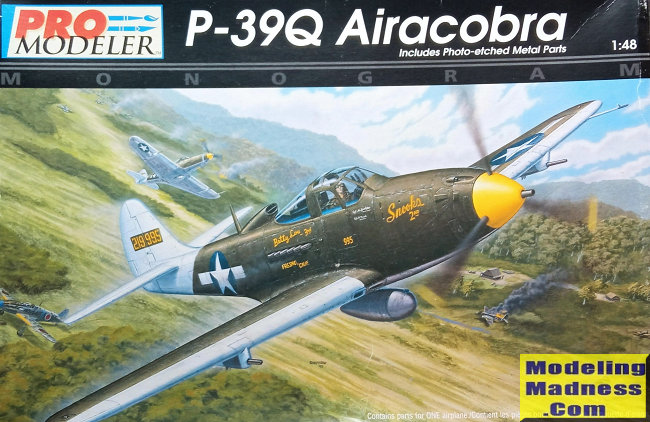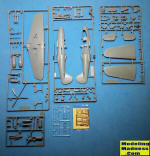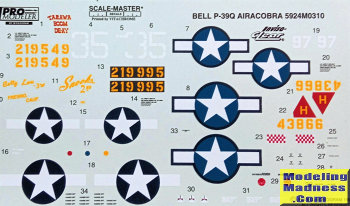
| KIT #: | 5294 |
| PRICE: | €35 in 2001 |
| DECALS: | Three options |
| REVIEWER: | Spiros Pendedekas |
| NOTES: |

| HISTORY |
One of the principal
American fighters in service when the United States entered WWII, the P-39 had
an innovative layout, with the engine installed in the center fuselage behind
the pilot, driving the propeller via a long shaft and was also the first fighter
fitted with a tricycle undercarriage.
Although the (cursory, as it turned out) decision not to equip the engine with
an efficient turbo-supercharger had a deleterious effect in high altitude
performance (it being the main reason this very fine machine was rejected by the
RAF), the plane was a really good performer at altitudes where the engine
allowed it to exhibit its full potential. Apart from the Pacific Theater, this
was even more clearly shown at the Eastern Front. With most air combat taking
place at medium and lower altitudes, the Airacobra enabled individual Soviet
pilots to collect the highest number of kills attributed to any U.S. fighter
type flown by any air force in any conflict.
Other major users of the type included the Free French, the Royal Air Force, and
the Italian Co-Belligerent Air Force, with a total of 9,588 units built.
| THE KIT |
 Pro
Modeler is a branch of Revell - Monogram that was established sometime in the
mid-90s decade, their kits typically featuring Monogram or other manufacturers
molds, usually with extra parts, very comprehensive instructions, nice decals
(typically Scalemaster) and also a complimentary “Pro Modeler” poster and a
badge, all attractively packed. Needless to say, the Pro Modeler line made an
impact upon its launch back then. Such is the case with this kit, which includes
the basic 1969 venerable P-39 Monogram mold with extra goodies, bought still
wrapped from a, sadly now closed, toy/hobby shop in my hometown (Chalkis,
Greece) in 2001 at the “expected” (back then) not exactly low price of €35.
Pro
Modeler is a branch of Revell - Monogram that was established sometime in the
mid-90s decade, their kits typically featuring Monogram or other manufacturers
molds, usually with extra parts, very comprehensive instructions, nice decals
(typically Scalemaster) and also a complimentary “Pro Modeler” poster and a
badge, all attractively packed. Needless to say, the Pro Modeler line made an
impact upon its launch back then. Such is the case with this kit, which includes
the basic 1969 venerable P-39 Monogram mold with extra goodies, bought still
wrapped from a, sadly now closed, toy/hobby shop in my hometown (Chalkis,
Greece) in 2001 at the “expected” (back then) not exactly low price of €35.
The kit comes in the usual top opening Monogram box, with an extremely
attractive box art of “ The Flying Undertaker” Lt. Col. William Shomo’s “Snooks
2nd” bird on a mission against a Japanese airfield in 1944. Upon opening the
box, I was greeted with 68 medium gray styrene parts, arranged in four sprues.
Of them, the three are more or less equally sized and they are your venerable
1969 Monogram mold, whereas the fourth smaller one is clearly a newer mold,
containing the wing gun pods, two figures and a few detailing parts.
By examining the sprues, one can easily recognise that the basic kit was a
departure from the 60’s Monogram trend and does not provide toy-like features.
Detail is, of course, raised all over, save some hinges, and quite nicely done.
The wing walk lines are molded with a grainy texture, something that a number of
us might not like. Also a few ejector pin marks are found at places they
shouldn’t have been, like, for example, the lower side of the elevators,
compromising the otherwise very nicely rendered fabric effect. Molding is
quite good with surprisingly little flash for its 1969 origins, with the newer
sprue being even crisper.
Cockpit is well appointed by the styrene parts, containing all basic stuff that
was in the real thing, with the nicely done PE fret providing quite many tiny
detail parts to beef it up. The nose cannon and gun assembly area also exhibit a
good level of detail. Since the starboard access panel is removable, you can
show this area, but bear in mind that the kit is a primary candidate for tail
sitting and I doubt you will find sufficient room to stuff sufficient weight
should you go for the open gun bay option.
Landing gear is also sufficiently represented. The main bays are nicely boxed,
but the very distinctive nose bay lacks a bit, exhibiting void areas, especially
aft. At least, the “classic” section where the prop shaft can be seen is
well done. The tires are provided as ‘’weighted”, with the main ones “bulginess”
tad overdone to my eyes (they look “flat-ish”), so you might consider lightly
sanding the “weighted” sides to reduce the effect. Again PE is provided to
either replace (oleo scissors) or supplement (gear door retraction struts) the
area.
The distinctive radiator/oil cooler underside triple exits are averagely molded,
with the central being not only oversimplified, but also containing a hole, in
order to attach a transparent rod, should your tail sitting avoidance efforts
fail. Options include central drop tank or bomb attachment, open or closed
starboard entry door and ditto engine access panels, however the starboard
engine part that will be visible (which is molded together with the fuselage
half) is simplistic looking. Two styles of exhaust stacks are also provided.
 Transparencies
are well done, flash free and clear. Instructions are superb, coming to the form
of a 20 B4 page b/w booklet, containing a short history of the type at the
front, with the construction spread in 14 main steps, each of them containing a
few substeps, accompanied not only by extremely comprehensive texts in every
respect, but also containing a plethora of Bert Kinzey’s “Detail & Scale” b/w
photos. Genuinely, instructions cannot get better.
Transparencies
are well done, flash free and clear. Instructions are superb, coming to the form
of a 20 B4 page b/w booklet, containing a short history of the type at the
front, with the construction spread in 14 main steps, each of them containing a
few substeps, accompanied not only by extremely comprehensive texts in every
respect, but also containing a plethora of Bert Kinzey’s “Detail & Scale” b/w
photos. Genuinely, instructions cannot get better.
Three schemes are provided, for two Pacific Theater birds (Major Joseph Powell’s
“Tarawa Boom Deay” and Lt. Col. William Shomo’s “Snooks 2nd”) and a Sixth Air
Force bird based at Howard Field, Panama. Decals are supremely printed by
Scalemaster and, despite being almost 30 years old at the time of this writing,
look in usable condition.
Instructions want you to first assemble the cockpit and gun bay and then trap
it, together with the nose gear leg and exhausts, between the fuselage halves.
The main wing is then assembled and attached, followed by the horizontal
stabilizers. The wing gun pods, the main landing gear and the external stores
come next, followed by the canopy, prop, starboard entry door and access panels.
Last two steps deal with the antenna wire fitting and figures; painting, ending
an uncomplex (save the PE parts that a number of us find more demanding) and
seemingly pleasant build.
| CONCLUSIONS |
This elderly fellow by
any means intends to compete with the modern Eduard very nice offering, let
alone the even more recent Hasegawa superlative one. However, concerning its
age, this is a good kit of the iconic Airacobra. General shapes of parts look
correct, the key areas (like cockpit and landing gear) are sufficiently
detailed, molding is good and the same can be said for the transparencies.
Instructions are superb and decals are second to none, with the nice PE fret
being the icing on the cake. Out of the box, a very nice Airacobra can emerge.
The PE fret, together with the nice decal sheet and the Pro Modeler poster and
badge might possibly justify the relatively high price this kit was offered when
new, which has risen further up lately due to its collectivity. However, Revell
reissued sometime in 2009 the basic kit (no PE, no poster and badge) at a really
low price (Andrew Abshier has done a nice preview of
that kit).
In any case, this is still a nice kit, definitely worth building
Happy Modeling!
February 2023
Copyright ModelingMadness.com. All rights reserved. No reproduction in part or in whole without express permission.
If you would like your product reviewed fairly and fairly quickly, please contact the editor or see other details in the Note to Contributors.